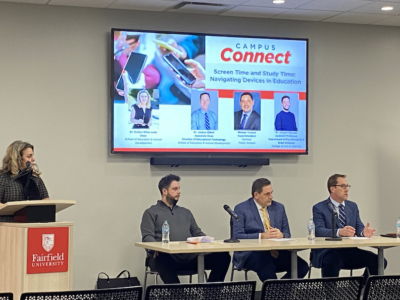
FAIRFIELD – As students spend more time on screens in school and at home, parents are faced with trying to find a safe median for their child’s mental well-being.
A study published by JAMA Pediatrics on Monday, Feb. 3, finds that students spent a significant portion of the school day on their phones, with messaging, Instagram, and video streaming among the most-used apps.
Researchers also noted that a quarter of students logged more than two hours of screen time during class. In addition, students whose parents held bachelor’s degrees or higher spent about a half-hour less on their phones during school hours compared to kids whose parents did not have college degrees. The study showed that adolescents between the ages of 13 and 18 spent 8.5 hours per day using screen-based media.
This issue was the subject of a Fairfield University “Campus Connect” panel discussion at the college bookstore Jan. 30. Two psychological and educational leaders as well as the dean of the School of Education and Human Development at Fairfield University Evelyn Bilias Lolis joined Fairfield School Superintendent Michael Testani to tackle screen time vs. study time.
“The one thing I can say with certainty is there a digital divide,” Testani said. “When Covid hit, devices were not readily available to give out to every child across the (school) building and to go home on March 19 (when the country closed down). We had a lot of work to do in that area.”
However, Testani has observed that is no longer the case.
“One thing is certain is that every child, no matter what socioeconomic background, has one of these things (as showed a smartphone),” he added. “When it comes to the digital divide as far as accessing social media, like Facebook, Instagram, SnapChat and all of that, it has completely evened the playing field.”
As a longtime school administrator, Testani has seen what overusing smartphones and other screen-based media has on teen students.
“The impact it has is the same,” he said. “It causes anxiety, bullying, stress and other forms of aggression that we see in the hallways. It does not matter. I can tell you that with certainty.”
He mentioned that the complaints he received from parents in high school and elementary school in Bridgeport is the same he is getting in Fairfield.
“The only common denominator is their access through the phone to the platforms,” he said. “I think that’s what’s alarming. It’s similar to drugs. It affects every community in our nation. It’s spreading rapidly and we need to do something about it quickly.”
He mentioned how his school district has even tinkered with limiting cell phone use in the classrooms through a process they have started using in middle schools.
“Pretty much, every teacher has a shoe tree in the classroom,” he said. “(There are cases where) the students will put their phones in there. Here in Fairfield, the middle schoolers have to leave them in the locker or in their backpack.”
But talk of an all-out ban, which has been suggested by Gov. Ned Lamont, is a bit excessive, Testani believes.
But the use of such media in the classrooms is not all bad. A professor and associate dean from Fairfield University described how even smartphones and laptops can be an educational tool when used in moderation.
“The kids know the devices,”said Joshua Elliott, associate dean and director of educational technology at the School of Education and Human Development, who sat on the panel. “They don’t necessarily know the effectiveness of the digital use. We don’t want them to just be consumers; we want them to be producers.”
Elliott talks about how changing things up in the teaching process can be beneficial to students of all ages.
“There is the possibility of flipping the classroom, where you are doing a lot of work outside the classroom,” he said. “There is the ability to see what the students are engaged in. And also if I’m able to see your work before you come in, I’m able to gauge your understanding even before you come and walk in the door.
“The learning can be very real. We can bring an expert into our classroom. It is also important to harness that piece.
He suggests integrating artificial intelligence (AI) into the learning experience by having students use it to find answers and learn about the subject just like AI does.
But Elliott stresses how important it is for educators to moderate that screen time for their students in the classroom in order for those devices to become educational tools.
“It’s good to know when to shut it down and have a conversation,” he said. “Even when I taught intech classes, we would shut it down and go to the library, have a cup of coffee at Peet’s.”
Professor Joseph DeLuca, who teaches in Fairfield University’s Department of Psychological and Brain Sciences, is concerned about how technology as a whole in the classroom.
“It’s really important to disentangle when we talk about digital technology,” DeLuca told the panel audience. “We’re talking about a lot of different things. We’re not just talking about social media. We’re not just talking about tablets. We need these more nuanced ways to talk about technology. From a psychology perspective, you have to make sure these tools are being used in a developmental way.”
Panel moderator Evelyn Bilias Lolis, Fairfield University’s dean of school of education and human development, had a piece of advice for parents of teens.
“Even as a parent, there is no passive supervision,” she said. “If we’re going to be supervising in terms of not just monitoring but also having conversations with our children about how they are using it, (we need to ask) what are the benefits, where you might want to steer away from it. You have to be an active participant in that part of their journey.”



















